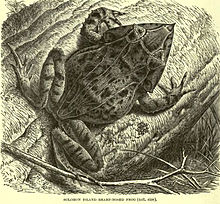Ceratobatrachidae
The Ceratobatrachidae are a family of frogs.[1][2] They live in the Malay Peninsula, Borneo, the Philippines, Palau, Fiji, New Guinea, and the Admiralty, Bismarck, and Solomon Islands.[1]
| Ceratobatrachidae | |
|---|---|

| |
| Cornufer guentheri | |
| Scientific classification | |
| Domain: | Eukaryota |
| Kingdom: | Animalia |
| Phylum: | Chordata |
| Class: | Amphibia |
| Order: | Anura |
| Family: | Ceratobatrachidae Boulenger, 1884 |
| Type genus | |
| Ceratobatrachus Boulenger, 1884
| |
| Genera | |
|
5, see text. | |
| Synonyms | |
|
Ceratobatrachinae | |
Taxonomy
changeScientists used to think of Ceratobatrachidae as a subfamily (i.e., Ceratobatrachinae) in the family Ranidae (true frogs), but now they call it a separate family. The following genera are in Ceratobatrachidae:[1]
- Subfamily Alcalinae Brown, Siler, Richards, Diesmos, and Cannatella, 2015
- Alcalus (5 species)
- Subfamily Ceratobatrachinae Boulenger, 1884
- Cornufer Tschudi, 1838 (> 50 species)
- Platymantis Günther, 1858 (> 30 species)
- Subfamily Liuraninae Fei, Ye, and Jiang, 2010
- Liurana Dubois, 1987 (4 species)
Some other genera used to be in Ceratobatrachidae, but scientists now think the frogs that used to be in these genera should be in the genera above.
- Batrachylodes Boulenger, 1887 (8 species)
- Palmatorappia Ahl, 1927 (1 species)
- Ceratobatrachus Boulenger, 1884 (1 species)
- Discodeles Boulenger, 1918 (5 species)
Distribution
changeCeratobatrachidae live across Island Southeast Asia,[3] as well as in the Eastern Himalayas.
- Genus Liurana
- Eastern Himalayas: 4 species
- Genus Alcalus
- Borneo: 2 species (Alcalus baluensis and Alcalus rajae)
- Palawan: 1 species (Alcalus mariae)
- Genus Platymantis
- Philippines:
- Genus Cornufer
- Palau: 1 species
- Maluku: 3-4 species
- New Guinea: 6-8 species
- Bismarck Archipelago: 18-22 species
- Solomon Islands: 20-25 species
- Fiji: 2 species
Life history
changeAll Ceratobatrachidae lay eggs outside of water and undergo direct development. That means the eggs hatch into small frogs and are never tadpoles.[4]
References
change- ↑ 1.0 1.1 1.2 Frost, Darrel R. (2014). "Ceratobatrachidae Boulenger, 1884". Amphibian Species of the World: an Online Reference. Version 6.0. American Museum of Natural History. Retrieved 22 February 2014.
- ↑ "Ceratobatrachidae Boulenger, 1884". Integrated Taxonomic Information System.
- ↑ Brown, Rafe M.; Siler, Cameron D.; Richards, Stephen J.; Diesmos, Arvin C.; Cannatella, David C. (2015). "Multilocus phylogeny and a new classification for Southeast Asian and Melanesian forest frogs (family Ceratobatrachidae)". Zoological Journal of the Linnean Society. 174 (1): 130–168. doi:10.1111/zoj.12232.
- ↑ Fuiten, Allison Marie (2012). Skeletal Variation in Melanesian Forest Frogs (Anura: Ceratobatrachidae). M.A. thesis , University of Kansas. p. 69. Retrieved 22 February 2014.